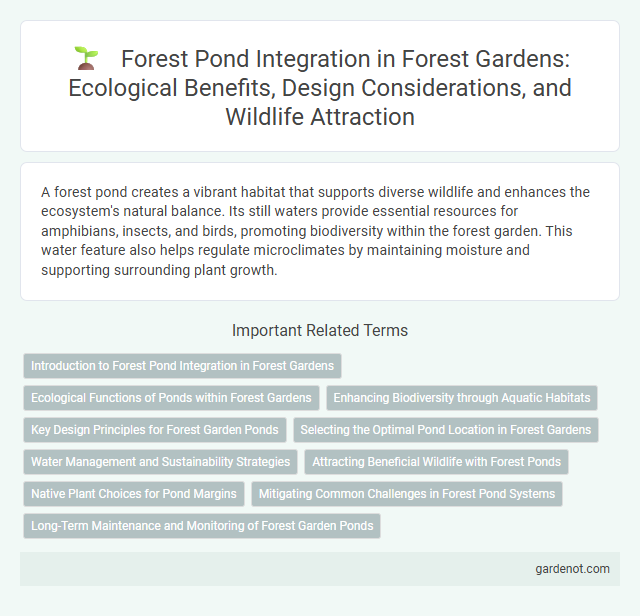A forest pond creates a vibrant habitat that supports diverse wildlife and enhances the ecosystem's natural balance. Its still waters provide essential resources for amphibians, insects, and birds, promoting biodiversity within the forest garden. This water feature also helps regulate microclimates by maintaining moisture and supporting surrounding plant growth.
Introduction to Forest Pond Integration in Forest Gardens
Forest pond integration enhances biodiversity and supports natural water management within forest gardens by creating habitats for aquatic plants and wildlife. These ponds improve microclimates, promote beneficial insects, and assist in nutrient cycling, fostering a resilient and productive ecosystem. Incorporating forest ponds strategically maximizes water retention and encourages symbiotic relationships among plants, animals, and soil microorganisms.
Ecological Functions of Ponds within Forest Gardens
Forest ponds serve as critical habitats for diverse aquatic and terrestrial species, enhancing biodiversity within forest gardens. They regulate microclimates by maintaining humidity levels and moderating temperature fluctuations, which supports plant growth and resilience. These ponds also function as natural water reservoirs, improving water retention and promoting nutrient cycling essential for sustainable forest garden ecosystems.
Enhancing Biodiversity through Aquatic Habitats
Forest ponds serve as vital aquatic habitats that enhance biodiversity by providing shelter and breeding grounds for various amphibians, insects, and bird species. The presence of native aquatic plants supports water filtration and offers food sources for wildlife, promoting ecological balance within the forest garden. Integrating forest ponds contributes to sustainable water management and creates microhabitats essential for maintaining diverse flora and fauna populations.
Key Design Principles for Forest Garden Ponds
Forest garden ponds enhance biodiversity by incorporating native aquatic plants and creating varied depths to support diverse wildlife habitats. Strategic placement maximizes natural water runoff collection while minimizing disruption to existing root systems and soil structure. Integrating gradual, sloping edges and nearby shade from native trees promotes balanced water temperature and provides shelter for amphibians and beneficial insects.
Selecting the Optimal Pond Location in Forest Gardens
Choosing the optimal pond location in forest gardens requires assessing natural water flow patterns and ensuring proximity to diverse plant species for ecological balance. Selecting a site with adequate sunlight supports aquatic life and encourages beneficial insects, while avoiding low-lying areas prone to stagnant water minimizes mosquito breeding. Integrating these factors enhances biodiversity and promotes a sustainable, thriving forest garden ecosystem.
Water Management and Sustainability Strategies
A forest pond enhances water management by capturing rainwater and supporting groundwater recharge, reducing erosion and runoff. Integrating native aquatic plants improves water quality through natural filtration and offers habitat for beneficial wildlife, promoting ecological balance. Sustainable strategies include rainwater harvesting systems and controlled overflow mechanisms to maintain optimal water levels throughout seasonal changes.
Attracting Beneficial Wildlife with Forest Ponds
Forest ponds create vital habitats that attract beneficial wildlife such as amphibians, dragonflies, and pollinators, enhancing biodiversity within the forest garden ecosystem. These water sources support natural pest control by providing breeding grounds for predatory insects and frogs that reduce harmful insect populations. Integrating forest ponds increases ecosystem resilience, promoting a balanced and healthy garden environment.
Native Plant Choices for Pond Margins
Selecting native plants for forest pond margins enhances biodiversity and supports local wildlife by providing natural habitat and food sources. Species like pickerelweed (Pontederia cordata), blue flag iris (Iris versicolor), and marsh marigold (Caltha palustris) thrive in wet soils and improve water quality by stabilizing banks and filtering pollutants. These native plants contribute to a balanced ecosystem, reducing erosion while attracting pollinators and amphibians essential for pond health.
Mitigating Common Challenges in Forest Pond Systems
Forest ponds often face challenges such as nutrient imbalance, stagnation, and invasive species that can disrupt ecosystem health. Implementing native aquatic plants helps filter excess nutrients, improve oxygen levels, and provide habitats for beneficial organisms. Regular monitoring and adaptive management strategies ensure the pond maintains ecological balance and supports biodiversity in the forest garden.
Long-Term Maintenance and Monitoring of Forest Garden Ponds
Regular inspection of forest ponds ensures stable water quality and supports biodiversity by detecting early signs of pollution or invasive species. Maintaining natural vegetation around the pond stabilizes banks, reduces erosion, and provides habitat for pollinators and amphibians crucial to forest garden ecosystems. Implementing seasonal water level adjustments and sediment removal promotes long-term ecological balance and prevents habitat degradation.
Forest pond Infographic

 gardenot.com
gardenot.com